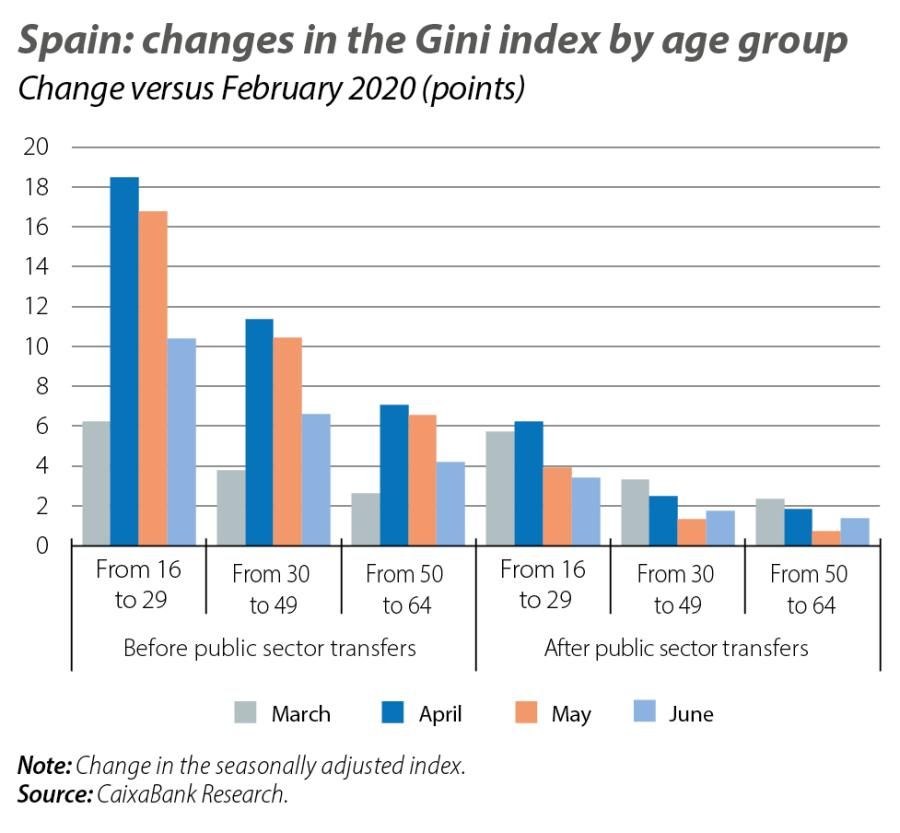
Tracking inequality in real-time: impact of the actvity rebound
The COVID-19 crisis would have led to a sharp increase in inequality if the actions taken by the public sector had not cushioned it to some extent. The high levels of inequality recorded during the peak of the crisis are gradually decreasing thanks to the recovery in business.
Throughout history, pandemics and wars have had a profound impact on income and wealth distribution,1 so it is no surprise that the COVID-19 crisis has set off all the alarms. Indeed, the economic impact of this pandemic is of such a magnitude that the rise in inequality could have been extreme, were the action of the public sector not there to dampen it. On the other hand, the recovery in economic activity after the Spring lockdowns has already begun to be reflected in the inequality indices, which are gradually declining from their high levels registered at the peak of the crisis.
These are the main messages drawn from the update of the inequality tracker performed by the team of researchers from Pompeu Fabra University, the Institute of Political Economy and Governance (IPEG) and CaixaBank Research.2 By analysing internal CaixaBank data, specifically payroll payments (logically anonymised) and applying big data techniques to manage the large volume of information available (some three million payrolls are analysed each month),3 we have built the tools necessary to track the impact that the economic crisis is having on workers’ wage incomes and on wage inequality in general, in real-time.4
- 1See W. Scheidel (2018). «The great leveler: Violence and the history of inequality from the Stone Age to the twenty-first century». Princeton University Press. Wade (2020). An unequal Blow. Science. Vol. 368, Issue 6492, pages 700-703.
- 2The team consists of Oriol Aspachs (CaixaBank Research), Ruben Durante (ICREA-UPF, IPEG and Barcelona GSE), Alberto Graziano (CaixaBank Research), Josep Mestres (CaixaBank Research), José G. Montalvo (UPF, IPEG and Barcelona GSE) and Marta Reynal-Querol (ICREA-UPF, IPEG and Barcelona GSE).
- 3With 27% of all payrolls, CaixaBank has the highest market share in Spain.
- 4Aspachs et al. (2020). «Real-Time Inequality and the Welfare State in Motion: Evidence from COVID-19 in Spain». Barcelona GSE Working Paper.

Specifically, when we analyse changes in wage income without incorporating transfers from the public sector, we see that inequality (measured using the Gini index) registered a sudden and sharp increase during the months of March and April. However, beginning in May and especially during June, as the lockdowns began to be lifted and economic activity began to be revived, the Gini index clawed back some of the ground it had lost over the previous months. Thus, while in April the Gini index was 11 points above the level recorded in February,5 in June the increase versus pre-crisis levels amounted to 6 points. This is still a very significant increase, but clearly lower than that recorded at the peak of the crisis.
- 5To put these 11 points into context, according to OECD data they are equivalent to the inequality gap between the US (Gini index of 39 points) and Sweden (Gini index of 28).

When we take account of transfers made by the public sector, such as unemployment benefits or those received by workers affected by furlough schemes (ERTEs), the picture is somewhat different. The rise in the level of inequality is still pronounced, but much lower. In this case, the Gini index for June was «only» 2 points higher than the figure for February and 1.6 points below the level reached in April.
Moreover, the impact of the crisis is not uniform across the different groups within society. The rise in inequality, both before and after transfers from the public sector, was particularly marked among younger people and immigrants. In the case of young people, the increase in the Gini index amounted to 18 points in April when excluding public sector transfers, and 6 points when these transfers are incorporated into the analysis. For people born outside Spain, the increase in the index was 17 points before public sector transfers and 5 points after.
It is important to emphasise that young people and immigrants are also the groups who are benefiting the most from the revival of the labour market. As can be seen in the charts, the Gini index before public sector transfers fell significantly for both groups between May and June, registering a 7-point reduction in each case.
The significant swings in the Gini index of these two groups reflect a well-known problem of the Spanish labour market: its duality. These groups have more people working in precarious conditions and, therefore, they suffer the most when economic shocks occur: they account for a large portion of the workers who lose their jobs and they are less covered by public sector aid. For this same reason, they are also the groups that are benefiting the most from the current economic revival. However, reducing the duality of the labour market is imperative for reducing their vulnerability in the long term.

Finally, the analysis of the changes in inequality by autonomous community region also reveals some marked differences. As can be seen in the charts, the increase in the Gini index in April was pronounced and widespread across all regions when excluding public sector transfers. However, the rise was particularly pronounced in the Balearic Islands and the Canary Islands, two autonomous communities where tourism plays a particularly important role. In contrast, in June inequality had reduced considerably across the board thanks to the rebound in activity after the Spring lockdowns, although some differences remained. However, once we take public sector transfers into account, the increase is much lower, and the regional differences are substantially reduced.





